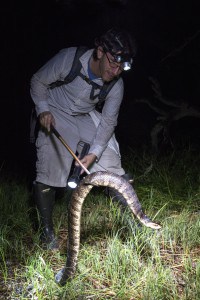Share this article
Missing seabirds spell trouble for snakes
On Seahorse Key, an island on Florida’s Gulf Coast, seabirds used to swoop into the water to pick up fish, and fly away while inadvertently dropping some on the ground for Florida cottonmouth snakes (Agkistrodon conanti) to indulge in.
But last spring about 20,000 colonial nesting birds — herons, egrets, ibises, pelicans, cormorants and others — mysteriously abandoned the 150-acre mangrove-covered dune in a hurry — leaving in their wake some very hungry snakes.
“Snakes rely heavily on fish or carrion that the birds drop,” said Coleman Sheehy, the associate director of Seahorse Key Marine Laboratory and a research assistant and professor at the University of Florida. “Marine and colonial nesting birds bring in fish to feed their young that can either get regurgitated or fall on the ground. Snakes rely on that to eat at Seahorse Key, and with the birds gone, snakes are getting very hungry.”
Sheehy has found now that they’re going into the second summer without fish falling, he is seeing far fewer snakes as well as more dead snakes and ones with poor body condition. And with a reduced menu, the snakes are resorting to cannibalism. “We’ve seen that twice,” Sheehy said. “We had never seen that before here. It’s not surprising in these dire conditions because they have a generalized diet and eat other snakes. But they’re typically eating fish and not each other. If this happens a lot, it can decrease the population quickly.”
Meanwhile, aerial photographs showed 1,500 to 3,000 birds — representing all species on Seahorse Key except for very few white ibis (Eudocimus albus) — took refuge in nearby Snake Key, about two miles east of Seahorse Key, and the cottonmouth snakes there are doing well, Sheehy said. “The silver lining is that we’re able to use long-term data to monitor this transition occurring and cottonmouths reacting to changing resources,” he said.
An unsolved mystery

Sheehy captures an adult Florida cottonmouth on Seahorse Key, Florida. Cottonmouth snakes are mainly nocturnal, and most of the field work is conducted at night. ©Marisol Amador
One year later, refuge staff still doesn’t know what caused the birds to simply up and leave and where most of them went. There are two theories, however: traumatic disturbance — according to Sheehy, military helicopters flew over the island shortly before the birds disappeared; and raccoons — researchers and managers have collected more raccoons than ever before on Seahorse Key; or, perhaps, a combination of the two.
While the reason for the increase in raccoons is unknown, Sheehy says refuge managers continue to remove them from the island so that birds can return in the future. Refuge staff is also trying to establish flight restrictions during the birds’ nesting season. If the military flights were routine practices, he says they could be restricted from the island, but if it was part of some sort of special operation, that would take precedent over the birds. Currently, Seahorse Key is restricted to the public each year during March, April, May and June, and the refuge is currently working on putting similar restrictions on Snake Key to protect the newly-established colony there.
As for where the remaining birds escaped, Sheehy is not positive although he says there was recently a sighting of some seabirds on a nearby small island north of the coast. Refuge staff plans to look into this further.
Meanwhile, Sheehy is hopeful that the birds will return to Seahorse Key. In fact, there have been recent independent and as yet unconfirmed reports of 60 or so double-crested cormorants sitting on nests in the island, he said.
Sheehy and his colleagues plan to continue monitoring the transition for the birds and snakes carefully. He will keep track of population size changes, body condition data and the snakes’ new diets. “These islands have had shifts throughout time, but no one has had this kind of an opportunity to document how they affect wildlife on the islands,” he said.
Header Image: A juvenile Florida cottonmouth snake forages along the beach at Seahorse Key, Fl. The snake is eating a small piece of fish that washed up onto the beach. ©Coleman Sheehy III








